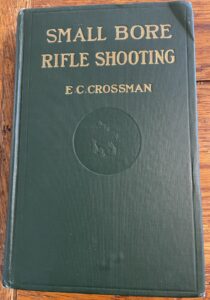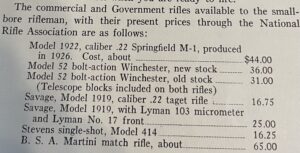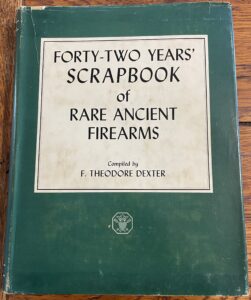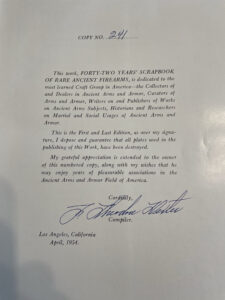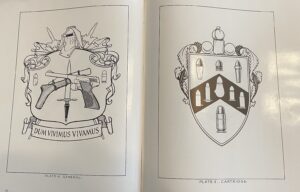I did manage to make it to the post office yesterday, and picked up some packages that had been waiting for me. All of which contained gun books.
So, continuing our ongoing epic…
Small Bore Rifle Shooting, E.C. Crossman. This has a 1927 copyright date, and is without dust jacket as issued. Per Smith’s bibliography, Samworth prepared 2,900 copies, and bound 2,000 in the first printing. The other 900 copies were bound separately, but “are indistinguishable from the first issue described above”. No other editions are documented: again per Smith, this book sold out fast and was superseded by .22 Caliber Rifle Shooting by C.S. Landis.
I’d call this very good. If it wasn’t for the knock to the top right corner, I’d say near fine: the lettering isn’t faded, there’s no foxing to the pages, and there’s only a tiny bit of wear to the bottom of the binding. This is in darn nice shape for a 95 year old book. Purchased off eBay for $50+tax, based on a pointer from my book buddy in the Association.
This is Samworth book number four in sequence, so it is quite an early work. It is intended to give the reader a guide to getting started in the then new sport of competitive shooting with .22 caliber rifles. Before this, most target shooting was done with heavy center fire military or military style rifles, and that game got kind of expensive. Also, shooting with the .22 produced less noise and required less room.
Obviously, I haven’t had a chance to go all the way through it yet, but I have already found some fun stuff. For example, this table:
According to the inflation calculator I use, $36 in 1927 works out to $612.77 in 2022 dollars. I’ll buy Winchester Model 52 rifles all day for $600.
Also, surprise/not surprise: Captain Crossman has some very nice things to say about the Winchester Model 52.
I believe the Model 52 is the most accurate small-bore rifle ever produced on a quantity basis, not excepting the Springfield which was for a time much less accurate than the 52, and cannot, even now, be any more accurate in the long run.
However, his favorite rifle for the sport seems to be the “Springfield M-1 Model 1922“, with what he refers to as the “N.R.A. stock”. In general, he doesn’t seem to be happy with the stocks on almost any of the rifles he discusses.
Edward C. Crossman, from what I’ve been able to pick up, was a major gun writer of the early 20th century. He wrote two other books for Samworth: The Book of the Springfield and Military and Sporting Rifle Shooting, along with a variety of articles for “American Rifleman” (and the precursor, “Arms and the Man”.) There’s a profile of him in the 2010 Gun Digest (which I do not have) and some biographical information in Casada’s introductions to the Firearms Classics Library reprints of his books (which I also do not have). Apparently, he committed suicide in 1939 after his wife was killed in a car accident.
Fourty-Two Years’ Scrapbook of Rare Ancient Firearms, F. Theodore Dexter. This is an odd one, also recommended to me by my book buddy and bought off eBay for $19.99 (plus tax and shipping). I’d say this is “good”: the jacket has some wear at the top and bottom, and there’s about a three-inch tear on the left side near the binding. But this is also pretty rare: my copy is #241 of 2,000 printed.
Pretty much what it says on the tin: an illustrated compendium of various rare old firearms from various collections, with commentary. One of the fun things in the book is a selection of “Arms Heraldry Designs and Ornaments: Suggestions for the embellishment of the Arms Collector’s personal stationery”. This gives me some ideas…
Next time, if the boll weevils don’t get into the cotton, I want to talk about snub-nosed revolvers, Browning High Powers, and whether there is any help for the widow’s son.
